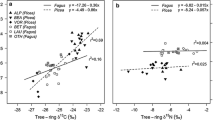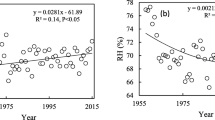Abstract
Purpose
The chemistry of annual tree growth rings is affected by precipitation pH, and tree rings store information on environmental conditions at the time of ring formation. The purpose of this study was to evaluate the potential use of tree ring chemistry data in estimating historical precipitation pH using the relationship between precipitation pH and tree ring chemistry.
Materials and methods
Red pine (Pinus densiflora) stem disks were collected from a forest in southern Korea and analyzed for C isotope ratio (13C/12C, expressed as δ 13C), N concentration, N isotope ratio (15N/14N, expressed as δ 15N), and molar Ca/Al in annual growth rings. Correlation analysis was conducted for the relationship between tree ring chemistry and precipitation pH between 1992 and 2005 for which such data were available. A regression equation between precipitation pH and tree ring chemistry was then developed using stepwise multiple regression analysis.
Results and discussion
We found that between 1992 and 2005, δ 15N (−0.4‰ to −2.7‰) and Ca/Al (11.6 to 7.3) decreased in the growth rings (all significant at α = 0.05) with precipitation pH decreased from 5.7 to 5.0, while the amount of NO x emission increased from 12.7 to 22.1 thousand tons between 1999 and 2005 in the study area. The decreased δ 15N and Ca/Al in the tree rings associated with the decreasing precipitation pH seemed to reflect increased N deposition originated from NO x emission that is known to be depleted in 15N relative to the soil mineral N and reduction in Ca availability due to soil acidification. The regression model indicated that mean annual precipitation pH values before the late 1990s at the study site fluctuated between 5.5 and 6.8; thereafter, it showed a decreasing pattern below 5.4 (the lowest measured and estimated pHs were 5.2 and 5.0, respectively) in the mid-2000s with increasing NO x emission.
Conclusions
The significant correlation of precipitation pH with δ 15N and Ca/Al in tree rings suggested that it may be possible to use tree ring chemistry to estimate historical precipitation pH. However, δ 13C and N concentration of tree rings were not useful as indicators of acid precipitation in this study, as δ 13C is an integrator of many environmental factors that affect gas exchange and inter-ring movement of N towards the outermost ring may mask time-related information regarding N availability. Further research is needed to validate the model in regions where long-term precipitation pH records are available.








Similar content being viewed by others
References
Barton CD, Karathanasis AD, Chalfant G (2002) Influence of acidic atmospheric deposition on soil solution composition in the Daniel Boone National Forest, Kentucky, USA. Environ Geol 41:672–682
Bert D, Leavitt SW, Dupouey JL (1997) Variations of wood δ 13C and water-use efficiency of Abies alba during the last century. Ecology 78:1588–1596
Bogan RA, Ohde S, Arakaki T, Mori I, McLeod CW (2009) Changes in rainwater pH associated with increasing atmospheric carbon dioxide after the industrial revolution. Water Air Soil Pollut 196:263–271
Bondietti EA, Momoshima N, Shortle WG, Smith KT (1990) A historical perspective on changes in cation availability to red spruce in relationship to acidic deposition. Can J For Res 20:1850–1858
Brady NC, Weil RR (2002) The nature and properties of soils, 13th edn. Pearson Education, Upper Saddle River
Bukata AR, Kyser TK (2005) Response of the nitrogen isotopic composition of tree-rings following tree-clearing and land-use change. Environ Sci Technol 39:7777–7783
Bukata AR, Kyser TK (2007) Carbon and nitrogen isotope variations in tree-rings as records of perturbations in regional carbon and nitrogen cycles. Environ Sci Technol 41:1331–1338
Cement Association of Korea (2006) Statistical yearbook of Cement Association of Korea. Cement Association of Korea, Seoul
Choi WJ, Chang SX, Allen HL, Kelting DL, Ro HM (2005a) Irrigation and fertilization effects on foliar and soil carbon and nitrogen isotope ratios in a loblolly pine stand. For Ecol Manage 213:90–101
Choi WJ, Lee SM, Chang SX, Ro HM (2005b) Variations of δ 13C and δ 15N in Pinus densiflora tree-rings and their relationship to environmental changes in eastern Korea. Water Air Soil Pollut 164:173–187
Choi WJ, Chang SX, Bhatti J (2007) Drainage affects tree growth and C and N dynamics in a minerotrophic peatland. Ecology 88:443–453
Damesin CD, Barbaroux C, Berveiller D, Lelarge C, Chaves M, Maguas C, Maia R, Pontailler JY (2005) The carbon isotope composition of CO2 respired by trunks: comparison of four sampling methods. Rapid Commun Mass Spectrom 19:369–374
DeWalle DR, Tepp JS, Swistock BR, Sharpe WE, Edward PJ (1999) Tree-ring cation response to experimental watershed acidification in West Virginia and Maine. J Environ Qual 28:299–309
Elhani S, Lema BF, Zeller B, Brechet C, Guehl JM, Dupouey JL (2003) Inter-annual mobility of nitrogen between beech rings: a labeling experiment. Ann For Sci 60:503–508
Farquhar GD, O’Leary MH, Berry JA (1982) On the relationship between carbon isotope discrimination and the intercellular carbon dioxide concentration in leaves. Aust J Plant Physiol 9:121–137
February EC, Stock WD (1999) Declining trend in the 13C/12C ratio of atmospheric carbon dioxide from tree rings of South African Widdringtonia cedarbergensis. Quatern Res 52:229–236
Fowler D, Cape JN, Coyle M, Flechard C, Kuylenstierna J, Hicks K, Derwent D, Johnson C, Stevenson D (1999) The global exposure of forests to air pollutants. Water Air Soil Pollut 116:5–32
Galloway JN, Zhao D, Xiong J, Likens GE (1987) Acid rain: China, United States, and a remote area. Science 236:1559–1562
Heaton THE (1986) Isotopic studies of nitrogen pollution in the hydrosphere and atmosphere: a review. Chem Geol 59:87–102
Herbauts J, Penninckx V, Gruber W, Meerts P (2002) Radial variations in cation exchange capacity and base saturation rate in the wood of pedunculate oak and European beech. Can J For Res 32:1829–1837
Hirano Y, Mizoguchi T, Brunner I (2007) Root parameters of forest trees as sensitive indicators of acidifying pollutants: a review of research of Japanese forest trees. J For Res 12:134–142
Hlawiczka S, Dyduch B, Fudala J (2003) Long-term changes of particulate emission in the industrial region of upper Silesia (Poland) and their effect on the acidity of rainwater. Water Air Soil Pollut 142:151–163
Holmes RL (1983) Computer-assisted quality control in tree-ring data and measurements. Tree Ring Bull 43:69–78
Kang H, Lee WS (2001) Responses of maternal siblings of Pinus densiflora to simulated acid rain. J Plant Biol 44:131–140
Kim JU, Yim YJ (1988) Environmental gradient analyses of forest vegetation of Mt. Naejang, southwestern Korea. Korean J Bot 31:33–39
Kuang YW, Wen DZ, Zhou GY, Chu GW, Sun FF, Li J (2008) Reconstruction of soil pH by dendrochemistry of Masson pine at two forested sites in the Pearl River Delta, South China. Ann For Sci 65, article 804
Kume A, Tsuboi N, Satomura T, Suzuki M, Chiwa M, Nakane K, Sakurai N, horikoshi T, Sakugawa H (2000) Physiological characteristics of Japanese red pine, Pinus densiflora Sieb. et Zucc., in declined forests at Mt. Gokurakuji in Hiroshima Prefecture, Japan. Trees Struct Funct 14:305–311
Kwak JH, Choi WJ, Lim SS, Arshad MA (2009a) δ 13C, δ 15N, N concentration, and Ca-to-Al ratios of forest samples from Pinus densiflora stands in rural and industrial areas. Chem Geol 264:385–393
Kwak JH, Lim SS, Park HJ, Lee SI, Lee KH, Kim HY, Chang SX, Lee SM, Ro HM, Choi WJ (2009b) Relating tree ring chemistry of Pinus densiflora to precipitation acidity in an industrial area of South Korea. Water Air Soil Pollut 199:95–106
Lee CS, Kil JH, You YH (1998) Effects of simulated acid rain on histology, water status and growth of Pinus densiflora. Korean J Ecol 21:117–124
Lee JS, Jung GB, Kim JH, Kim WI, Yun SG, Im JC (2001) Volume-weighted ion concentration of rainwater in Taean area. Korean J Environ Agric 20:284–288
Loader NJ, Robertson I, McCarroll D (2003) Comparison of stable carbon isotope ratios in the whole wood, cellulose and lignin of oak tree-rings. Palaeogr Palaeocl 196:395–407
Mandre M, Ots K, Rauk J, Tulmets L (1998) Impact of air pollution emitted from the cement industry on forest bioproduction. Oil Shale 15:353–364
Martin B, Sutherland EK (1990) Air-pollution in the past recorded in width and stable carbon isotope composition of annual growth rings of Douglas-Fir. Plant Cell Environ 13:839–844
Meko DM, Graybill DA (1995) Tree-ring reconstruction of Upper Gila River discharge. Water Resour Bull 31:605–616
Ministry of Environment of Korea (2007) Annual reports of ambient air quality in Korea. Ministry of Environment, Seoul (in Korean)
Momoshima N, Bondietti EA (1990) Cation binding in wood: applications to understanding historical changes in divalent cation availability to red spruce. Can J For Res 20:1840–1849
Ott RL, Longnecker M (2001) An introduction to statistical methods and data analysis, 5th edn. Thomson Learning, Pacific Grove
Penninckx V, Glineur S, Gruber W, Herbauts J, Meerts P (2001) Radial variations in wood mineral element concentrations: a comparison of beech and pedunculate oak from the Belgian Ardennes. Ann For Sci 58:253–260
Poulson SR, Chamberlain CP, Friedland AJ (1995) Nitrogen isotope variation of tree rings as a potential indicator of environmental change. Chem Geol 125:307–315
Roden JS, Bowling DR, McDowell NG, Bond BJ, Ehleringer JR (2005) Carbon and oxygen isotope ratios of tree ring cellulose along a precipitation transect in Oregon, United States. J Geophys Res Biogeosci 110:G02003
Rural Development Administration of Korea (2000) Detailed Korea Soil Map. Rural Development Administration, Suwon
Sakata M, Suzuki K, Koshiji T (2001) Variations of wood δ 13C for the past 50 years in declining Siebold’s beech (Fagus crenata) forests. Environ Exp Bot 45:33–41
Savard MM, Bégin C, Smirnoff A, Marion J, Rioux-Paquette E (2009) Tree-ring nitrogen isotopes reflect anthropogenic NO x emissions and climatic effects. Environ Sci Technol 43:604–609
Shan Y (1998) Effects of simulated acid rain on Pinus densiflora: inhibition of net photosynthesis by the pheophytinzation of chlorophyll. Water Air Soil Pollut 103:121–127
Shan Y, Izuta T, Aoki M, Totsuka T (1997) Effects of O3 and soil acidification, alone and in combination, on growth, gas exchange rate and chlorophyll content of red pine seedling. Water Air Soil Pollut 97:355–366
Sheppard PR, Thompson TL (2000) Effects of extraction pretreatment on radial variation of nitrogen concentration in tree rings. J Environ Qual 29:2037–2042
Song KJ, Choi YC, Lee KJ (1996) Acid rain and airborne pollutants effects on the needle of some conifer species—a case study of injured index and contact angle. Korean J Environ Ecol 10:76–86
Sun F, Kuang Y, Wen D, Xu Z, Li J, Zuo W, Hou E (2010) Long-term tree growth rate, water use efficiency, and tree ring nitrogen isotope composition of Pinus massoniana L. in response to global climate change and local nitrogen deposition in Southern China. J Soils Sediments 10:1453–1465
Warren CR, Dreyer E (2006) Temperature response of photosynthesis and internal conductance to CO2: results from two independent approaches. J Exp Bot 57:3057–3067
Xiao HY, Liu CQ (2002) Sources of nitrogen and sulfur in wet deposition at Guiyang, southwest China. Atmos Environ 36:5121–5130
Acknowledgments
This work was supported by a grant (code: S121010L010000) from the Forest Science & Technology Projects, Korea Forest Service. Institute of Agricultural Science & Technology, Chonnam National University provided critical assistance with the collection and preparation of samples.
Author information
Authors and Affiliations
Corresponding author
Rights and permissions
About this article
Cite this article
Kwak, JH., Lim, SS., Chang, S.X. et al. Potential use of δ 13C, δ 15N, N concentration, and Ca/Al of Pinus densiflora tree rings in estimating historical precipitation pH. J Soils Sediments 11, 709–721 (2011). https://doi.org/10.1007/s11368-011-0355-2
Received:
Accepted:
Published:
Issue Date:
DOI: https://doi.org/10.1007/s11368-011-0355-2




